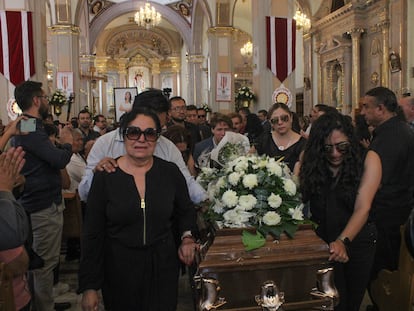In western Mexico, elections take place in the shadow of the drug war
Municipalities in the so-called ‘banana corridor’ are electing dozens of local and federal representatives in June. Booming economies, criminal gangs, old civil defense groups and hundreds of victims are intertwined with the vote
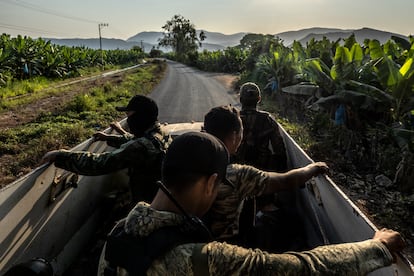

A young boy named Óscar Alejandro Ortega directs the group, which is made up of the relatives of missing people from Tecomán, a city in the small western Mexican state of Colima. He is only 16. While many kids his age are happily zoned out, he has spent the past year looking for his aunt.
“They don’t let me search,” he protests, “because I’m a minor.” He explains that the Attorney General’s Office prevents him from entering the properties near Tecomán, where officials and relatives — those of legal age, at least — search for the bodies of their loved ones in unmarked graves. The excuse is to protect him from horror… but no matter what, he still suffers every day because of the fact that his aunt, whom he used to live with, isn’t at home.
Óscar listens carefully to Mely Romero, a senatorial candidate for the PRI-PAN-PRD coalition, the principal opposition to the ruling Morena party. When he finally gets a chance to tell her his story, with the support of other relatives of missing people from all over the state, the candidate doesn’t really know what to say. In the hour that has passed since the meeting began, she has heard the complaints of mothers, sisters and grandmothers. They have filed reports through official channels and have been mistreated in the Attorney General’s offices. There’s been a prevailing refusal to investigate the disappearances of their loved ones, while they’ve also faced a constant revictimization. It’s common for a parent to be asked by police if their missing daughter ran off with a boyfriend, or if their missing son took drugs. “I’m going to raise my voice for you,” the candidate finally says. But young Óscar leaves her speechless.
The afternoon is sunny in the city, pleasant. People walking through the central gardens look at the posters that the families of the missing have placed on kiosks. There are photos of hundreds of faces of people who aren’t at home, the distressing reverse of the euphoric electoral propaganda that, as everywhere in the country, floods the streets.
Another one of Óscar’s aunts speaks with EL PAÍS. Her son has been missing since October of 2022. “When they come by, I ask them what the issue of missing people means to them,” she says, referring to politicians. “Because now, they give you the body and say it’s over, but no, no, I want to know what happened.”
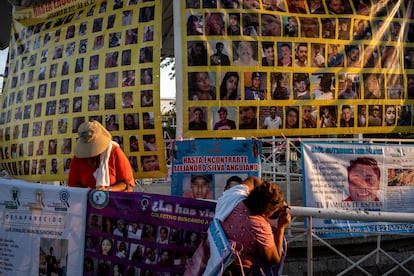
It’s the season for campaign promises. Romero, the candidate, says that “it’s not worth ignoring them,” pointing to the state and federal prosecutors’ offices. She promises to support the families if she’s elected and to apply pressure to ensure that their cases are addressed. Nothing concrete. However, the mothers, sisters and grandmothers say that she’s the only one who has come to see them.
After a while, more candidates from the opposition coalition appear: they are running for local and federal positions, including the municipal presidency. They talk to the family members of the disappeared and they listen. Then, they change. In the distance, a convoy of vehicles from the evangelical party Encuentro Solidario (“solidarity meeting”) circulates. Minutes later, the caravan bursts onto the street surrounding the gardens where the meeting is taking place. The militants blast music and throw lollipops. Everyone is silent for a moment.
Whether it serves a purpose or not, Romero’s meeting with nearly two dozen relatives of missing people illuminates a regional reality that transcends the limits of Tecomán. The phenomenon of disappearances also affects nearby towns and communities in the state of Michoacán, which is a stone’s throw from the city. Coahuayana, Aquila, or Ostula are all towns along a 50-mile-long corridor, in which a number of forces are at play. There are thriving economic sectors such as banana farming and the highly-lucrative mines, and powerful criminal organizations, as well as civil defense groups with more than 10 years of experience protecting the area. On June 2, thousands of residents will go to the polls to elect municipal presidents, local and federal deputies, senators, and other positions.
The forces at play sometimes grind you down. For instance, Candelaria Huerta has been looking for her son, who disappeared in 2018. She says that the banana industry, which employs thousands of workers between Tecomán and Coahuayana, has become a death trap. Women are usually in charge of washing and drying the fruit, before putting it in boxes. She tells EL PAÍS that she was going to take a job at a packaging plant, when she was told that criminals now force employees to either sell or purchase methamphetamines. One way or another, the work crews must pay for the product that gets delivered to them. Otherwise, the punishment may be disappearance, or death.
It’s a story that’s often repeated in the region, associated indiscriminately with the Jalisco New Generation Cartel (CJNG), a criminal group that operates while intertwined with regional problems. This situation is similar in other Mexican states, such as Zacatecas, Guanajuato, or Chiapas. In Tecomán, and Colima in general, the CJNG appears to be associated with dozens of murders and disappearances, as well as cases of extortion. With a population of only 740,000 people, the state registers the highest murder rate in the country per 100,000 inhabitants: it stands at above 110.
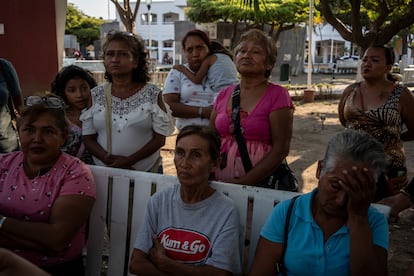
On the Michoacán side of the border, in the imagination of residents, the CJNG is a lurking monster. At least, that’s how it works in Coahuayana, where at the beginning of April residents blocked the bridge that spans the river and connects with Tecomán, after cartel members tried to ambush a civil defense convoy that was on its way up to the mountains.
Evangelina Contreras is one of the residents who participated in the blockade. “More than 100 criminals arrived in communities like El Órgano and El Churumo, where they burned houses. They took away the residents’ phones, because they started uploading what was happening to social media,” she explains.
The woman notes that the blockade of the bridge was a means of exerting pressure on the authorities to intervene. She heads an organization that supports displaced people who have arrived in Coahuayana in recent years. They’ve been pushed out of other parts of the states of Michoacán and Colima by crime. “Before, in December, [the CJNG] had already [set up] mines in a gap towards El Churumo. But right now, it’s like they’re storming the municipality,” she explains. The woman adds that the reason for these attacks “has to do with the local banana industry” and “the iron mines of Aquila,” some of the most important in the region.
On a ranch in Coahuayana, Pedro Sandoval shows EL PAÍS how a medium-sized banana orchard works. Thousands of plants surround the man, who presides over the local producers’ association, which consists of more than 300 members. The numbers are overwhelming: the banana plantations of Coahuayana cultivate 7,000 hectares, with each hectare producing about 60 tons of fruit per year. On a ranch like this, consisting of about 60 hectares, crews try to fill a trailer every few days, which has capacity for 1,300 boxes. Each box holds about 20 kilos of bananas, which means that each trailer can carry about 25 tons. A kilo of bananas earns about six or six-and-half pesos ($0.35 to $0.38).

“This industry moves a lot of money,” says Sandoval, a cautious man, who doesn’t say more than is necessary during his conversation with this newspaper. “Every week, just in payments to workers, fumigation and maintenance of the fields, seven million pesos ($410,000) are moved,” he calculates.
Sandoval heads towards today’s harvest area, where strong young men run with 50 kilo banana stalks to a kind of fruit zip line, which takes the harvest to the packaging plant. He says that about half of the annual production in Coahuayana, which amounts to about 350,000 tons, goes to the United States. The rest of the bananas stay in Mexico. In any case, he explains, the trailers must leave through Tecomán.
This transfer seems conflictive, given the pressure from the CJNG, which has turned the bridge with Tecomán into one of many irregular borders that operate in Mexico. Sandoval — who asks not to talk too much about “that” in this report — explains that they have no problem taking the trailers through Colima, assuring EL PAÍS that they don’t have to pay a single peso to criminal groups to move the goods. He doesn’t clarify what the agreement consists of, but he does say that, as of about 10 years ago when the civil defense groups rose up in Coahuayana, they’ve had no security problems on the plantations and no drug dealers forcing workers to buy methamphetamines under threat.
“How are they not going to pay them? Of course they pay them!” counters Commander Héctor Zepeda, leader of the Coahuayana self-defense groups. “One peso for every kilo of banana that leaves here… that’s what they pay, I know it,” he affirms. “I’ve told [the banana farmers] to go to the government and get them to do their job, because they,” he laments, referring to the CJNG, “control the trucks that pass through there.” He doesn’t mince words. Zepeda, known in the region as Commander Teto, is an auto parts salesman by profession. But back in 2014, he took up arms against the Knights Templar Cartel, the criminal group that was ravaging the region at the time.
The years have passed and Zepeda looks tired. “I am tired,” he agrees, “but more disappointed with the government. The government continues to view us with distrust!” he exclaims, referring to the executive branch and its forces on the ground: the Mexican army, navy and National Guard, which have bases and checkpoints in the area. “We aren’t against them… we’re against them supporting others,” he adds, pointing to the CJNG. “If we’re looking for culprits for what’s happening, it’s the government.”
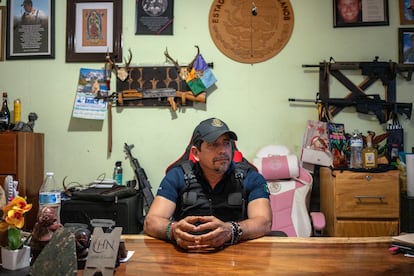
Zepeda and his men have lasted for a decade in Coahuayana. This is a rarity, given the murder, natural death, or flight of other civil defense commanders in Michoacán, such as José Manuel Mireles, Hipólito Mora, or Juan José Farías. The first died of Covid in 2020; the second was shot last year, while the third lives in seclusion in Tepalcatepec. The latter has become an enigma: it’s not known what he defends, or who. “It’s a shame what the government allows,” Zepeda continues ruefully. “Then, they claim that we’ve made a pact with I don’t know what bastards, [maybe] the United Cartels,” he says, referring to an assembly of local armed groups that fought against the CJNG for years. “But the same people have always supported us: the banana producers’ association,” he says.
Not far from Zepeda’s barracks lives Tony Valdovinos, one of the seven candidates for the municipal presidency of Coahuayana. A lifelong member of the Institutional Revolutionary Party (PRI), he resigned a few months ago and accepted the candidacy of Más Michoacán, a new local party. The candidate endorses Zepeda’s statements. The banana trees, he emphasizes, are the financial support of the self-defense groups. And the government, he adds, must get involved in the fight against the CJNG. “Here, in Coahuayana,” he acknowledges, “everything is important. But the most important thing is security. Because if there’s no security, everything collapses.”
Valdovinos, 56, boasts of being a fighter for social justice with extensive experience, as well as being the first gay councilor in the municipality, back in the 1980s. There was a time, he recalls, when a protest was organized against him because of his sexual orientation. But 40 years have passed and things have changed: he feels that his chances of winning and unseating the incumbent municipal president, Gil Ruiz, of the ruling Morena party, are high. “In the end, here, you need 1,700 votes to win… and I’m sure that the people [from the self-defense groups] are with me. That alone moves 700 votes my way,” he smiles. “They’re a political force.”
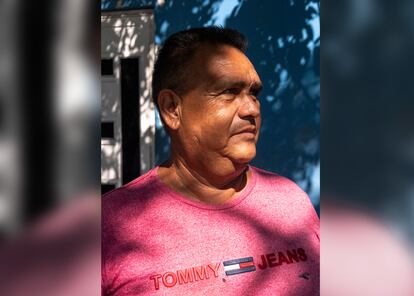
The town of the mines
Half-an-hour separates Coahuayana from Aquila. The road that connects the towns, in addition to drawing a beautiful meander over the cliffs, seems designed expressly for the carousel of trucks that leave Las Encinas mine, an old iron mine that has defined community life in Aquila for more than 40 years. The state of Michoacán is the main producer of iron in the country, representing almost a third of the more than nine million tons that mining companies extract on an annual basis, according to the Ministry of Economy. Aquila, a municipality of barely 25,000 inhabitants, has the second-most-important iron mine in Michoacán.
In Aquila, as in Coahuayana, there’s a municipal police command, along with other community police or civil defense groups. Both bodies coexist… part of the regional oddities. The Aquila civil defense group operates in a half-finished house at the edge of town, heading to the mine. In the patio, an agent lying in a hammock says that the boss — the controversial Germán Ramírez, also known as Commander Toro — isn’t there. “He hangs out at his house, on the beach,” the man notes.
Ramírez is a controversial character, accused of collaborating with organized crime. According to the agent on the hammock, the local security forces in Aquila and Ostula, another community within the municipality, are continually hit by crime. Hence, they work together against the CJNG, something they have in common with their colleagues in Coahuayana. When asked about the situation in the mountains, Ramírez says that things are calm now, because the Mexican army maintains a checkpoint there. “It’s because of the elections,” he points out.
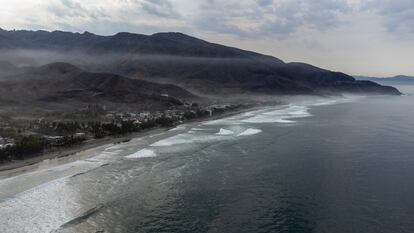
“Quiet” is a somewhat peculiar adjective to describe the state of things in the region. A week ago, a community member from Ostula, Antonio Regis, was murdered between Aquila and Ostula, when he was returning home with his wife and his two-year-old son. His community — an example of local organizing in the region — denounced the CJNG and said that, for months, the criminal group has controlled the routes between Ostula and the capital. In a statement, community leaders indicated that Regis was killed because he was from Ostula.
Regis’ case is the latest in a long list of attacks against the local population. The most emblematic case in recent years is that of Antonio Díaz, a member of the Aquila community, who disappeared along with the town’s lawyer, Ricardo Lagunes, in January of 2023. This occurred amid a conflict over the election of the authorities who administer the community property commissionerate. In Aquila, the commissariat is the body in charge of, among other things, distributing part of the funds that Ternium Argentina — the company that operates the mine — is required to give to the community.
Although the case continues to be investigated, the Attorney General’s Office indicates that the CJNG is responsible for the disappearance. Allegedly, the cartel was commissioned by Díaz’s rivals in Aquila, who have also been accused of crimes in the past. Disappeared on January 15, 2023, the authorities found the truck in which both men were traveling on the highway that connects Coahuayana with Tecomán, on the Colima side. Their bodies have not been found.
On the stretch of road where the authorities found the truck after the abduction, near a community called Cerro de Ortega, there’s no shortage of campaign billboards and posters, with euphoric smiles on white, blue, yellow and cherry backgrounds. Some trucks carry loads of iron and bananas, while others carry teams of orchard workers, circulating at full speed through the town. It’s strange to think that, in a land so beaten and longed for by everyone, an act as subtle as putting an envelope in a ballot box will occur.
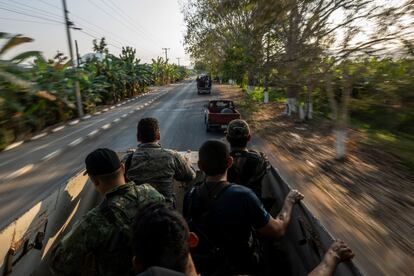
Sign up for our weekly newsletter to get more English-language news coverage from EL PAÍS USA Edition
Tu suscripción se está usando en otro dispositivo
¿Quieres añadir otro usuario a tu suscripción?
Si continúas leyendo en este dispositivo, no se podrá leer en el otro.
FlechaTu suscripción se está usando en otro dispositivo y solo puedes acceder a EL PAÍS desde un dispositivo a la vez.
Si quieres compartir tu cuenta, cambia tu suscripción a la modalidad Premium, así podrás añadir otro usuario. Cada uno accederá con su propia cuenta de email, lo que os permitirá personalizar vuestra experiencia en EL PAÍS.
¿Tienes una suscripción de empresa? Accede aquí para contratar más cuentas.
En el caso de no saber quién está usando tu cuenta, te recomendamos cambiar tu contraseña aquí.
Si decides continuar compartiendo tu cuenta, este mensaje se mostrará en tu dispositivo y en el de la otra persona que está usando tu cuenta de forma indefinida, afectando a tu experiencia de lectura. Puedes consultar aquí los términos y condiciones de la suscripción digital.
More information
Archived In
Últimas noticias
Most viewed
- Sinaloa Cartel war is taking its toll on Los Chapitos
- Oona Chaplin: ‘I told James Cameron that I was living in a treehouse and starting a permaculture project with a friend’
- Reinhard Genzel, Nobel laureate in physics: ‘One-minute videos will never give you the truth’
- Why the price of coffee has skyrocketed: from Brazilian plantations to specialty coffee houses
- Silver prices are going crazy: This is what’s fueling the rally

